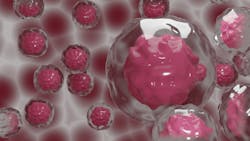A team of researchers from UCLA, Cedars-Sinai and the Cystic Fibrosis Foundation has developed a first-of-its-kind molecular catalog of cells in healthy lungs and the lungs of people with cystic fibrosis.
The catalog, referenced in the journal Nature Medicine, reveals new subtypes of cells and illustrates how the disease changes the cellular makeup of the airways. The findings could help scientists in their search for specific cell types that represent prime targets for genetic and cell therapies for cystic fibrosis.
A progressive genetic disorder that affects more than 70,000 people worldwide, cystic fibrosis results from mutations to the CFTR gene. Cells that contain the defective protein encoded by the gene produce unusually thick and sticky mucus that builds up in the lungs and other organs. This mucus clogs the airways, trapping germs and bacteria that can cause life-threatening infections and irreversible lung damage.
While several new therapies can partially restore the function of these damaged proteins, easing symptoms of the disease, slowing its progression and improving quality of life, these treatments only work in people with some of the many CFTR mutations that can cause cystic fibrosis.
The research team was assembled through the Cystic Fibrosis Foundation's Epithelial Stem Cell Consortium, which brings together scientists from across the U.S. in an ongoing effort to identify different subtypes of stem cells in the lungs and study their function. Because these cells can self-renew and produce a continuous supply of specialized cells that maintain, repair and regenerate the airways, therapies aimed at correcting CFTR mutations in stem cells hold the best hope for a one-time, universal treatment for the disease.
Researchers used a technology called single-cell RNA sequencing, which allowed them to analyze thousands of cells in tandem and classify them into subtypes based on their gene expression patterns — this is, which genes are turned on and off.
"The process is analogous to taking a smoothie and 'un-blending' it to discover all the ingredients it contains and measure how much of each ingredient was used," said Plath, a professor of biological chemistry and a member of the UCLA Broad Stem Cell Research Center.
Using a novel computer-based bioinformatics approach to compare the gene expressions patterns of the various cells, the team was able to create a catalog of the cell types and subtypes present in healthy airways and those affected by cystic fibrosis, including some previously unknown subtypes that illuminate how the disease alters the cellular landscape of the airways.
Specifically, the researchers discovered that among the basal cell populations, there was a relative overabundance of cells that appear to be transitioning from basal stem cells into specialized ciliated cells, which use their finger-like projections to clear mucus out of the lungs.
"We suspect that changes the basal cells undergo to replenish ciliated cells represent an unsuccessful attempt to clear mucus that typically accumulates in airways of patients with cystic fibrosis," Stripp said.
The increase in transitioning cells provides further evidence suggesting that expression of the mutated CFTR gene disrupts normal function of the airways, leading to changes in the way that basal stem cells produce specialized cells.

